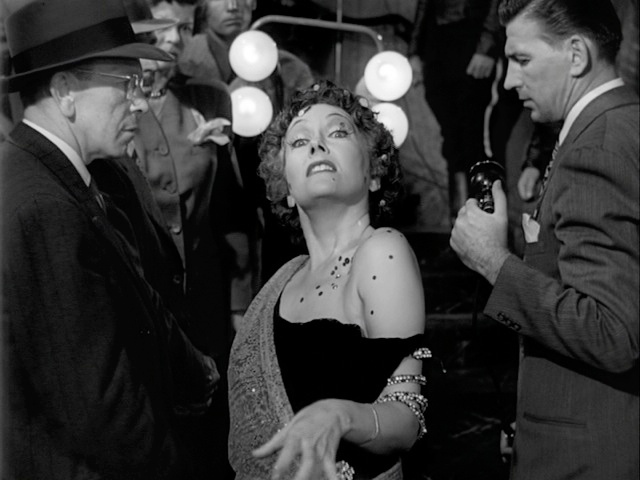
Gloria Swanson gives a fantastic ending in Sunset Boulevard. Courtesy Paramount Pictures
One of the best strategies to get a script sold is to tailor it for a bankable actor. That means you have to make sure your main characters grab attention from their entrance to their exit.
From a technical point of view, when you introduce lesser characters you do it this way:
BOB THE GROCER (35, thin, vegan) standing in produce.
Note that the intro is very spare, yet I used an adjective that suggests a lot. Vegan. This one word suggests a number of different actor types, costume choices, and moods, and might even factor in to later dialogue.
Now, if Bob the Grocer is your main character, you do it this way:
Standing in the produce section of a struggling co-op, BOB THE GROCER (35, soulful eyes, dreaming of a better world) holds a head of cauliflower in one hand lost in thought. Where would the world be without organic vegetables?
Basically, you “put a button” on his entrance. You make it more noticeable. Note the question at the end. You can’t film that, and typically the rule is don’t include a character’s thoughts. This is one of the few times when it makes sense to break the rule and bind your reader to the character. Use it sparingly.
Here are five films that utilize different kinds of entrances for main characters.
Laura (1944)
Postpone the entrance. In this classic noir, the entrance of the title character into the story is delayed. If you’ve seen the film you might wonder why I say that, since it begins with a shot of Laura’s portrait, which is a sort of entrance. But the portrait tells us that first we’ll be looking at the idea of Laura, the mystery of Laura.
We then learn that Laura has been murdered and we follow a detective attempting to find her murderer. After that, Laura is spoken about, she’s even shown in flashback. The flashback is another sort of entrance, though since it’s a story being told by another character it’s not completely reliable. Laura’s true entrance happens midway through the film when she returns from her country house very much alive. You can see this entrance in this compilation video at 2:04.
Notting Hill (1999)
Enter twice. Like Laura, this film begins with images of a mysterious woman. In this case, the opening credits are a montage of superstar Anna Scott’s career. She enters our imagination as the bigger than life movie star.
Then, in her second, real entrance into the film she shows up at Will’s travel bookstore to shop for a book. Shopping is something that movie stars don’t need to do for themselves so this sets up her character’s conflict, and indeed the conflict of the film, how does she manage to be a real person amidst the glamor of her movie star life. Effectively, Anna enters the movie once as a movie star, and then again simply as a girl. You can see part of that scene here.
Deadpool (2016)
Enter out of order. Sometimes, when telling a story, it’s very helpful to tell it out of order. In Deadpool the opening sequence shows the title character sitting on a bridge right before an action sequence. The sequence grabs the audience’s attention and at the same time introduces Deadpool’s irreverent character. After this scene, the film moves backward in time to tell the hero’s origin story. You can see the scene here.
The Meddler (2016)
Enter with character. This is a charming little film I happened to watch while thinking about this article. It opens with an extended phone message over a montage of Marnie’s life.
Marnie is a character with a very strong voice and verbal ticks (She opens her messages with “Anyway…”) Her entrance gives us a very strong sense of who she is. Instantly we know that she’s delightful in the way that other people’s parents often are, and incredibly annoying the way our own parents often are, setting up the main conflict of the film. The opening is not available yet—if you write character driven indie-style films this one is a must see.
Sunset Boulevard (1950)
Enter uniquely. Another classic noir, Sunset Boulevard begins at the end of the story with a man’s corpse floating in a swimming pool. That’s entering out of order, of course, as discussed above. What’s unique about this entrance though is that the narrator of the film, the main character, is the one floating in the pool. Having a dead man tell your story is a technique that can be risky, but one that works very well here.
Sunset Boulevard also features one of the strongest and most famous character exits ever filmed. After killing her lover, Norma Desmond has become unhinged and can only be coaxed out of her home with the ruse that she’s filming a movie. She comes down the stairs and, well, you can see it here.
Of course, you can and should mix and match these techniques using more than one to come up with strong entrances for your characters.
Be sure to put your favorite entrances (and exits) into the comments below.